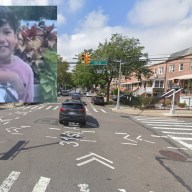By Michael Morton
The National Transportation Safety Board said the March 10 incident could have been prevented had crew members used a back-up system – the hand brake and wooden blocks behind the engine's wheels – as required by LIRR regulations. Crew members told the NTSB they had set the main air brake system.
Two of the four people injured remained in critical condition at Elmhurst Hospital Tuesday after their car was hit by the runaway engine before it came to a fiery halt two miles away. Another victim was in stable condition and the fourth had been released, according to a hospital spokeswoman.
“Obviously something went terribly wrong,” Mayor Michael Bloomberg said at a hastily called news conference after the accident. “We don't have an answer as to why. Obviously the brakes weren't set or the brakes didn't work – only time will tell.”
Investigators also discovered after the accident that leaking pressure from the air brakes could have led them to malfunction.
The locomotive rolled away March 10 and hit three cars passing over street crossings, none of which had warning lights, bells or safety gates, and two maintenance trucks parked down the track. Rail crossings were expected to be assessed for safety by the LIRR.
A firefighter also suffered minor injuries battling the blaze that erupted when the errant engine used to position LIRR passenger cars smashed into the two trucks in an industrial area filled with warehouses and businesses.
The NTSB said it must wait several weeks for the results of drug and alcohol tests on the crew to come back.
A LIRR union official told the Daily News that the same locomotive had started rolling away in another Queens yard on March 6, indicating a mechanical failure.
NTSB investigators based their analysis on a probe launched after the crash that focused on whether the brakes on the engine were properly engaged as it sat in the Fresh Pond Yard.
The locomotive broke away at 2:18 p.m. As it gained speed, it rumbled through several street crossings before slamming into a white sedan as it drove south over the tracks on 55th Street between Grand Street and Flushing Avenue. The engine dragged the car for 50 to 100 feet and tore it apart before shoving it into a fence just before the crossing at 54th Street.
“We heard the building shake,” said Joe Grauso, who works at a construction materials supplier on 54th Street.
Jason Kusinitz, 33, of Great Neck, and Demetrius Cuffie, 37, of Brooklyn who were in the white sedan, were in critical condition, a spokeswoman for Elmhurst Hospital said Tuesday. The two men are co-workers at a Ridgewood car rental agency.
At the next crossing, Metropolitan Avenue between Woodward and Flushing avenues, the locomotive smashed into a gray Dodge Intrepid and a gray Toyota Corolla, but the cars spun off and were not dragged.
The occupants of the two cars – Meir Mahlab, 72, a retired communications engineer from Forest Hills in the Dodge, and Sister Ave Clark, 59, a Bayside nun with St. Dominic of Amityville in Long Island in the Toyota – were in stable condition, the hospital spokeswoman said.
Employees from nearby buildings came out to see what had happened, and they said a railroad worker was shouting for people to get out of the way.
“Thank God for him,” said Jim Harnett, a manager at Globe International, a food equipment distributor near the crossing. “He's screaming, 'Get off the tracks! Get off the tracks!'”
The locomotive roared on and stopped near Varick Avenue after slamming into two trucks belonging to a work crew parked on the tracks 500 feet below the crossing. No one in the crew was injured, as they were on their lunch break.
“We just jumped out of the way and it demolished both my trucks,” which exploded into a ball of fire, said Carlos Rivera, who was doing work for the railroad.
Firefighters put out the fire, and Lt. William Pickett jumped in the engine's cab to shut down the motor and pull the emergency brake.
NTSB investigators said leaving an engine unmanned was not unusual.
“It's the circumstances of how it was left unattended,” Ed Dobranetski, the lead investigator, told reporters at LIRR'S Jamaica Station.
Dobranetski said his team was reviewing LIRR operating procedures as well as examining the brakes and other parts of the locomotive, which underwent a routine maintenance inspection two days before the accident.
Workers and residents in the area reported there had been close calls in the past between trains and vehicles at the Maspeth crossings where there are no lights, bells or safety gates. The spur is only used by the New York and Atlantic Rail Road for freight two or three times a week, a spokesman for the Metropolitan Transit Authority said, with a crew member jumping down at each crossing to warn traffic.
The state Department of Transportation determined in a 1991 study that “active devices were not required at those locations,” said spokeswoman Jennifer Post. But the NTSB's Dobranetski said the crossings had signals and gates until 1991, when they were removed for reasons he did not yet know.
Vincent Arcuri Jr., chairman of Community Board 5, which covers Maspeth, said electronic sensors were not feasible because of the tight confines of the area and said freight trains roll by slowly enough where the flagman can signal them to stop for traffic.
As for the reported close calls, Arcuri said, “it hadn't been a problem as far as we knew.”
It will take at least eight months for a full report on the accident to be issued, the NTSB's Dobranetski said, with the data from his investigation soon headed to the agency's headquarters in Washington, D.C., for analysis.
“We were lucky,” Bloomberg said at the news conference soon after the accident.. “This could have been a much worse tragedy and it was not.”
Reach reporter Michael Morton by e-mail at news@timesledger.com or call 229-0300, Ext. 154.

































